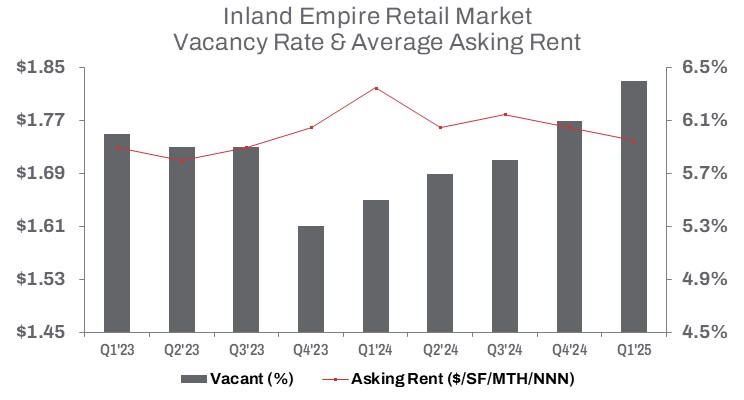First Quarter 2025
Retail Market in the Inland Empire Adapts to Evolving Tenant and Investor Demands in Q1 2025
Elevated vacancy and slowing rents were met with resilient demand, as Blackstone’s $4 billion acquisition of ROIC signaled ongoing investor confidence in stable, income-generating retail.
Deal flow will remain constrained by elevated borrowing costs and increasingly selective investor behavior.

MARKET OVERVIEW
The Inland Empire retail market showed mixed performance at the start of 2025 as the Federal Reserve held interest rates steady, sustaining high borrowing costs for investors, retailers and consumers in its ongoing effort to control inflation. In Q1 2025, the vacancy rate rose to 6.4%, up 30 basis points from the prior quarter and 90 basis points year-over-year. Leasing activity declined 26.1% quarter-over-quarter and 13.6% year-over-year, totaling nearly 667,000 square feet. Inflation, elevated interest rates, and recession fears are drove consumers to spend less and save more.
A series of high-profile retail bankruptcies intensified market challenges. Major chains—including JoAnn Fabrics, Walgreens, Macy’s, and Party City—have scaled back operations or shut down entirely in response to shifting consumer behavior and unrelenting pressure from e-commerce. Many have struggled with declining revenues, rising labor expenses, and escalating supply chain costs. This has been especially difficult for quick-service and fast-casual operators, where persistent inflation and food cost increases have forced menu prices higher and curbed spending. Meanwhile, renewed tariff threats threatened to raise costs and weaken consumer purchasing power further.
While the region had recovered approximately 3 million square feet of occupied space since Q1 2020, new headwinds emerged in 2025. Total vacant retail space remained elevated at 9.8 million square feet, as inflation and intensified competition continued to constrain spending at brick-and-mortar stores. Landlords responded by offering more concessions, and average asking rents declined 2.2% year-over-year to $1.74 per square foot triple net.
Some investors responded to market uncertainty by pivoting to sales, pushing Q1 2025 retail sales volume up a modest 2.6% from the previous quarter. However, volume was still down 36.0% year-over-year, totaling just over 900,000 square feet—the weakest start to a year since Q1 2021, when the market was still reeling from pandemic-related closures.
Weighed down by rising operational costs, economic uncertainty, and persistent cost-of-living pressures, the Inland Empire retail market saw a rocky start to 2025.
TRENDS TO WATCH
Landlords and sublessors will likely continue adjusting rents to boost cash flow and fill vacancies, especially as vacant sublease retail space jumped 31.1% quarter over quarter, compared to a 5.3% increase in direct space. The sharper rise in sublease space reflects businesses reevaluating their space needs under ongoing economic pressures. As tenants downsize or close underperforming locations, they are offloading excess space more quickly than landlords are delivering new vacancies. Sublessors, motivated to reduce carrying costs on unused space, are offering flexible lease terms and competitive pricing to attract tenants. This surge introduced a wave of new, often higher-quality listings, pushing average asking rents for subleases up 6.0% to $1.42 per square foot triple net. Despite this rise, sublease space remains a compelling value, offering an 18.4% discount ($0.32 per square foot) compared to direct space at $1.74, attracting cost-conscious tenants in a competitive market.
In Q1 2025, sales volume by square footage saw a modest quarter-over-quarter increase. However, on a dollar basis, transaction volume declined 44.2% from the prior quarter and 21.2% compared to Q1 2024. Alongside this decline, the average deal size fell to $2,061,621—down 24.0% from the previous quarter and 23.8% year-over-year.
These trends reflect the impact of elevated borrowing costs and increasingly selective investors, which continue to limit deal flow. The median sale price per square foot dropped 13.6% quarter-over-quarter to $262. With the Federal Reserve holding interest rates steady, transaction volume is expected to remain constrained in the near term.
In Q1 2025, a standout transaction saw Blackstone Real Estate Partners X L.P. acquire all outstanding common shares of Retail Opportunity Investments Corp. (ROIC) for $17.50 per share—an all-cash deal valued at approximately $4 billion, including assumed debt. The portfolio comprised 419 properties across the West Coast, including about 450,000 square feet in the Inland Empire. Local assets included Ontario Plaza in Chino Hills, The Shops at Sycamore Creek in Corona, Ontario Plaza in Ontario, and Palomar Village Shopping Center in Temecula.
This strategic move underscores Blackstone’s continued focus on high-growth, income-generating real estate. ROIC’s grocery-anchored shopping centers have proven resilient across economic cycles, aligning with Blackstone’s strategy of targeting stable assets that offer long-term cash flow potential. The Blackstone-ROIC merger also reflects a broader trend of investors gravitating toward necessity-based retail to hedge against volatility in the retail sector.
As investors recalibrate strategies to navigate rising borrowing costs and capitalize on rental demand, the retail market continues to adapt. In the Inland Empire, performance will be influenced by broader economic trends and capital market conditions. Market fundamentals are expected to remain solid, with elevated home prices in coastal cities driving population growth inland and sustaining demand for local brick-and-mortar retail.
However, slowing rent growth may place downward pressure on pricing as investors adapt to evolving market dynamics. Landlords and tenants alike are facing increased competition. With prime retail space in high demand, competition for well-located properties is intensifying. Despite offering incentives, landlords continue to face challenges in backfilling larger second-generation spaces left vacant by previous tenants.


































































